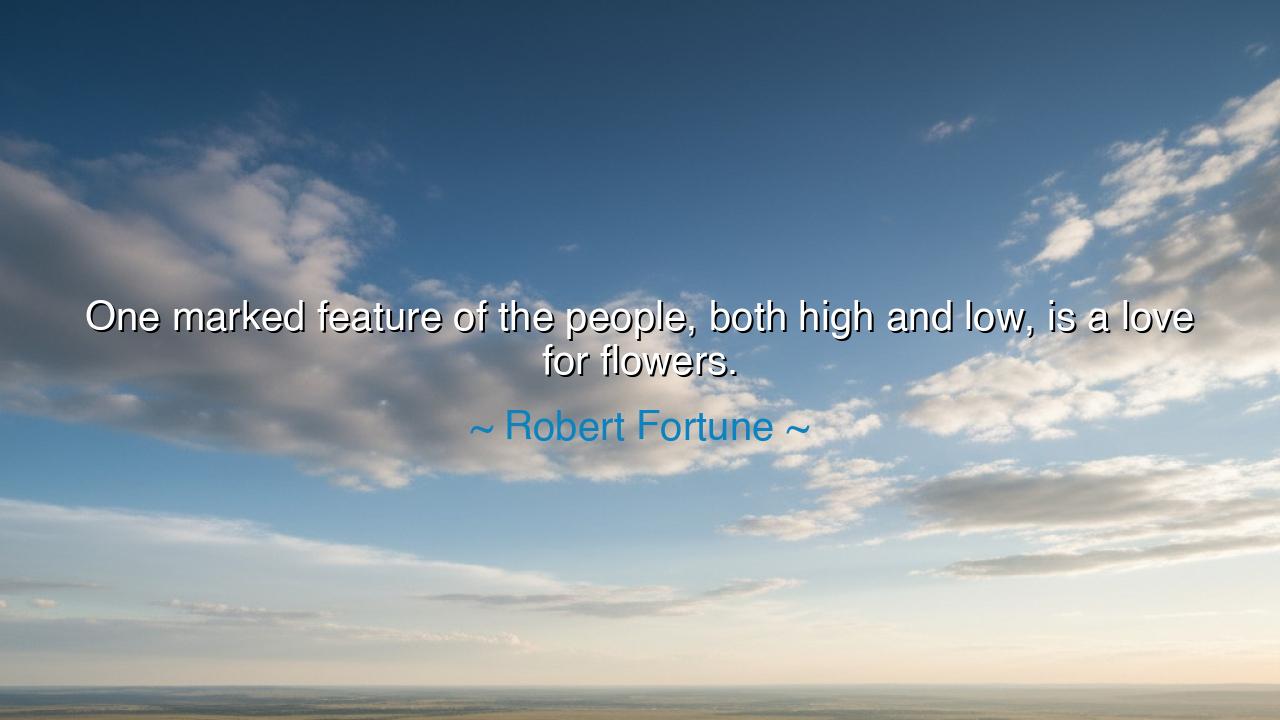
One marked feature of the people, both high and low, is a love






In the heart of every civilization, from the humble to the grand, there exists a universal truth—a truth that transcends the bounds of class, status, and even time itself. Robert Fortune, in his insightful observation, declares, "One marked feature of the people, both high and low, is a love for flowers." These words are not just an observation of the human condition, but a testament to the profound connection that binds us to nature. Flowers, in all their fleeting beauty, are a common ground upon which all can stand, a symbol of life's shared joys, aspirations, and even sorrows. From the gardens of the wealthy to the simple plots of the peasant, flowers evoke a universal love, one that speaks to something deep within the soul.
The ancients understood well the significance of the flower. To the Greeks, the flower was a symbol of transience, of the fleeting nature of life. The goddess Persephone, in her journey to the underworld, was associated with the cycle of death and rebirth, and the flowers that bloomed in spring were seen as a reflection of this eternal cycle. In the Roman world, flowers were not only admired for their beauty, but for their symbolism. The rose, for example, was linked to both love and mystery, embodying the contradictions of life itself—beauty mixed with the awareness of mortality. It was said that Venus, the goddess of love, held the rose as a gift, a token of life’s pleasures and pains intertwined. So, when Fortune speaks of the love of flowers shared by all people, he is acknowledging something ancient—the understanding that flowers, in all their forms, are symbols of life’s ephemeral beauty and the shared experiences that unite us as humans.
In the same vein, the Chinese, with their deep reverence for nature, have long associated flowers with spirituality and wisdom. The lotus, one of the most revered flowers in Chinese culture, is a symbol of purity and enlightenment. The lotus grows from the muddy depths of the water, rising above it to bloom in the sunlight. This powerful imagery speaks not only to the beauty of the flower but to the resilience of the spirit. In ancient China, the lotus was seen as a reflection of the soul’s potential for growth, no matter how dark the circumstances. The love for flowers, in this context, is not just about aesthetic pleasure, but a recognition of the spiritual lessons they offer—lessons of resilience, beauty, and the ability to rise above adversity.
Similarly, in the lush gardens of the Persians, flowers were not merely decorative; they were symbols of both earthly beauty and divine perfection. The famed Persian gardens were designed to reflect the paradise of the heavens, with flowers at the center of their carefully planned landscapes. The garden, with its flowers in full bloom, was seen as a mirror of the divine order, a space where man could commune with the gods through the beauty of the earth. Robert Fortune’s words resonate here, as he touches on the idea that flowers, with their universal appeal, are not just part of the earth’s beauty but are divinely inspired and part of a deeper, cosmic connection that binds all people to the natural world.
The love for flowers is not only a sentiment shared by the great and powerful, but also by the humble. The poor, throughout history, have often sought solace in the beauty of a flower. In ancient Egypt, where the people toiled under the scorching sun, the beauty of the lotus offered them a sense of peace and hope. Even in times of hardship, the flower represented something greater than themselves—a reminder of life’s resilience. The simple act of planting and tending flowers, no matter one’s status, became an act of spiritual affirmation, a quiet resistance against the burdens of life. Fortune’s words remind us that flowers, in their quiet beauty, are a shared language, one that speaks directly to the soul, regardless of one’s wealth or rank.
The lesson in Fortune’s words is one of connection. Flowers, in all their forms, teach us that beauty is both universal and transcendent. In gardens, both grand and humble, we find common ground—a space where we are all equal, united by a love for nature’s gifts. This shared love for flowers speaks to a deeper truth: that no matter our station in life, we all find meaning in the simple, ephemeral beauty of a bloom. The flowers are reminders that, though we may be different in our circumstances, we share in the same human experience of love, joy, suffering, and renewal.
So, let us take this wisdom and apply it to our lives. Let us plant flowers, not only for their beauty but as symbols of the shared experiences that unite us all. In a world that often divides us, flowers offer us a reminder of what we hold in common: the simple, unspoken beauty of life, the joy of growth, and the inevitable cycle of life and death. Whether we plant them in a grand garden or in a small pot by the window, let us remember that flowers are not just for the rich or the poor—they belong to all of us, as a sign of connection, renewal, and the shared beauty that makes us human. May we find in the love of flowers a path to unity, a recognition that no matter where we come from, we all have the capacity to appreciate the fleeting beauty of the earth.






AAdministratorAdministrator
Welcome, honored guests. Please leave a comment, we will respond soon